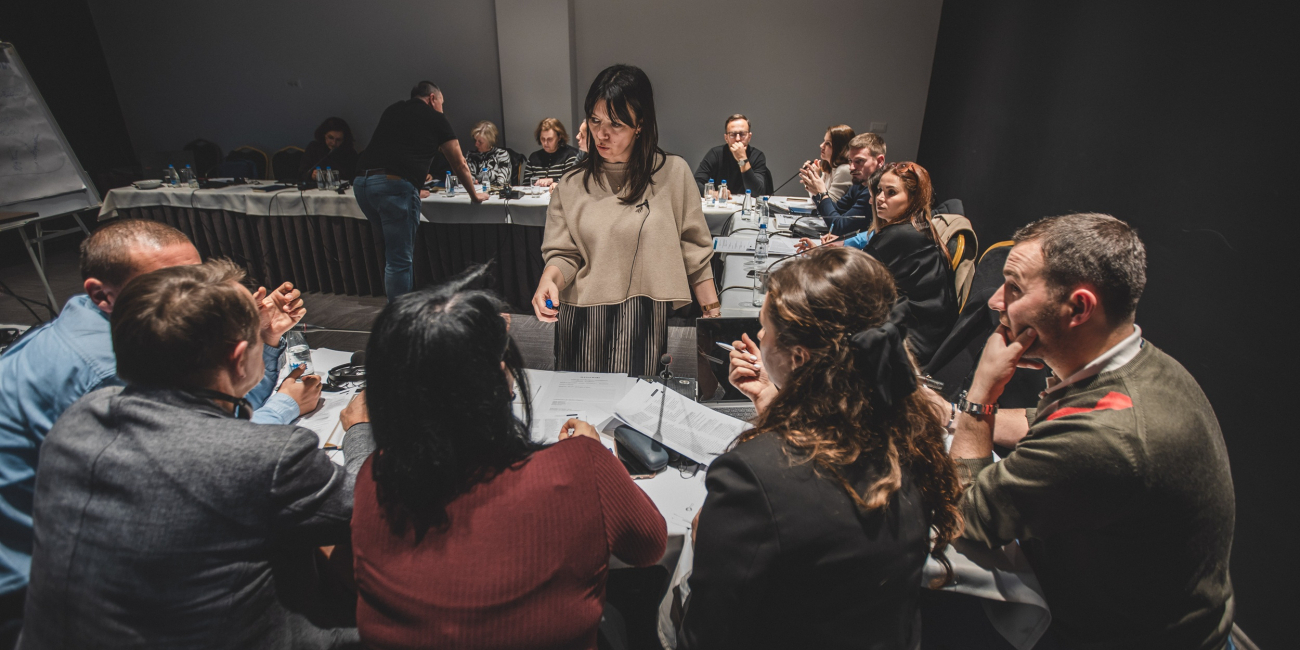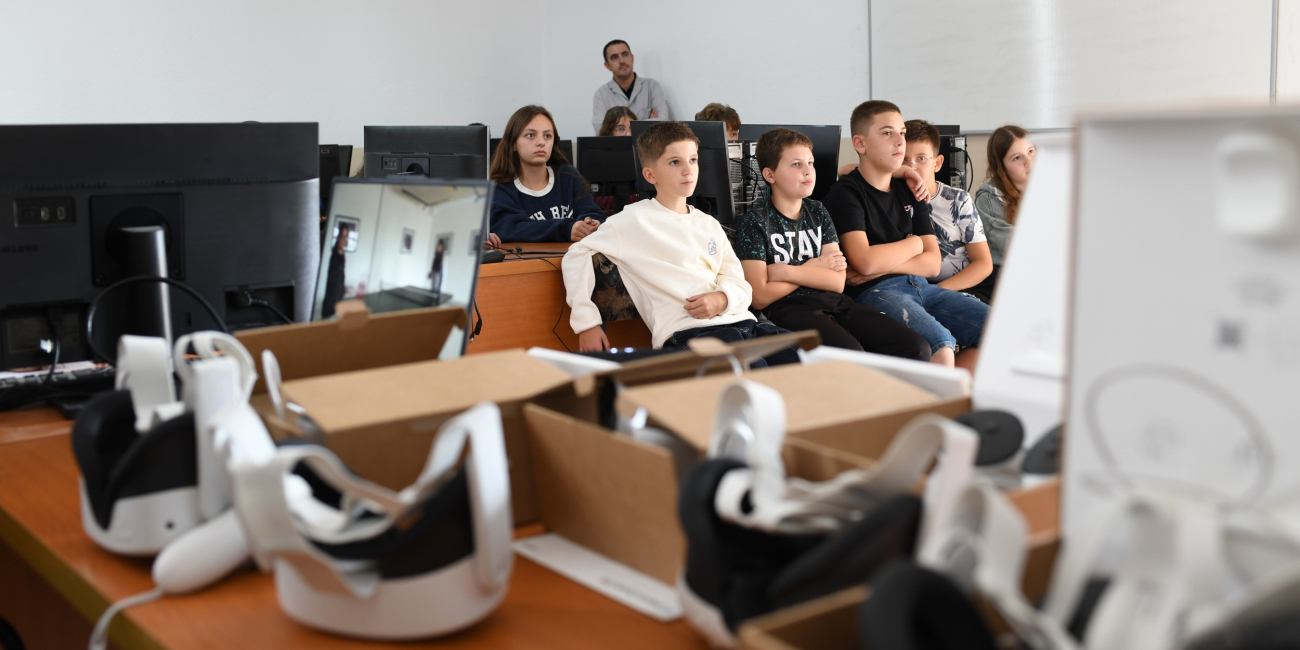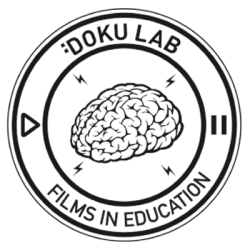DokuFest, in collaboration with the Humanitarian Law Center Kosovo, successfully conducted a series of teacher training workshops within the project…
Për qasje të plotë në Bibliotekën Digjitale ju duhet llogari aktive në DokuLab
2nd INTERCULTURAL SPRING CAMP
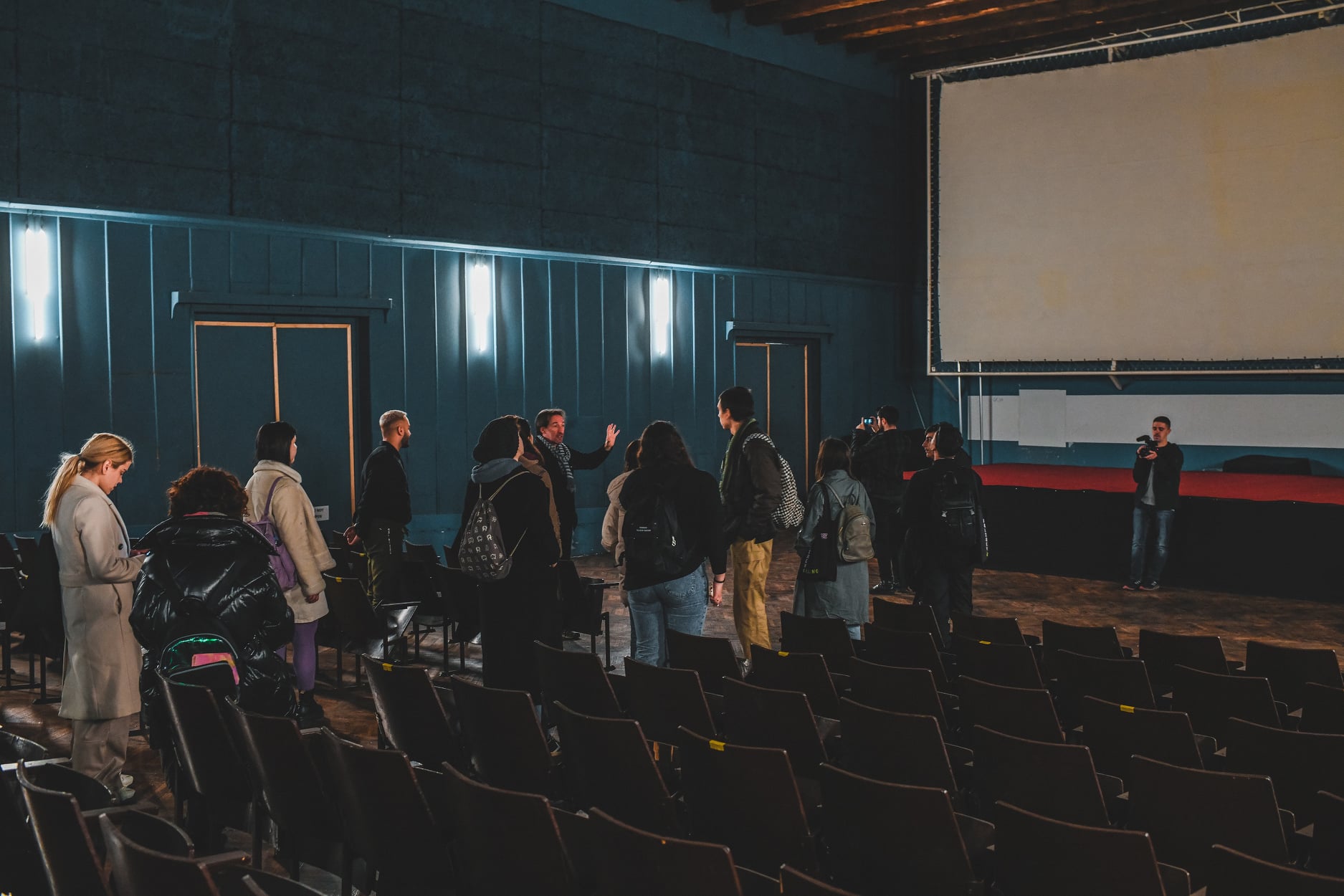 DAY 2
On the second day, we continued with our program in a timely manner, only having to fit in a short introduction to the Lumiere style of video making, which had been scheduled for the previous day.
The short introduction proceeded with a visit to the Lumbardhi Foundation & Cinema, as the staff welcomed us by explaining Lumbardhi’s history, activities, and beautiful archive. We then had a short break at the Lumbardhi Garden Cafe for refreshments before heading out to visit the ITP center (Innovation and Training Center Prizren).
One of the NGOs inhibiting this space and piqued our interest is Autostrada Biennale, which had transformed the formerly German KFOR base into a multifunctional, creative space. The presentation for the Biennale and Hangar was made by Leutrim Fisekciu, Vatra Abrashi, and Baris Karamuco, all founders of Autostrada Biennale.
After the lunch break, the participants had the opportunity to freely explore Prizren, and within that time frame, we encouraged them to bring back a Lumiere video, which we then presented and discussed with each of the participants.
In the evening, we encouraged participants to stay at DokuKino for a surprise film screening.
This eventful day was concluded by a dinner at Restaurant Marashi.
DAY 2
On the second day, we continued with our program in a timely manner, only having to fit in a short introduction to the Lumiere style of video making, which had been scheduled for the previous day.
The short introduction proceeded with a visit to the Lumbardhi Foundation & Cinema, as the staff welcomed us by explaining Lumbardhi’s history, activities, and beautiful archive. We then had a short break at the Lumbardhi Garden Cafe for refreshments before heading out to visit the ITP center (Innovation and Training Center Prizren).
One of the NGOs inhibiting this space and piqued our interest is Autostrada Biennale, which had transformed the formerly German KFOR base into a multifunctional, creative space. The presentation for the Biennale and Hangar was made by Leutrim Fisekciu, Vatra Abrashi, and Baris Karamuco, all founders of Autostrada Biennale.
After the lunch break, the participants had the opportunity to freely explore Prizren, and within that time frame, we encouraged them to bring back a Lumiere video, which we then presented and discussed with each of the participants.
In the evening, we encouraged participants to stay at DokuKino for a surprise film screening.
This eventful day was concluded by a dinner at Restaurant Marashi.
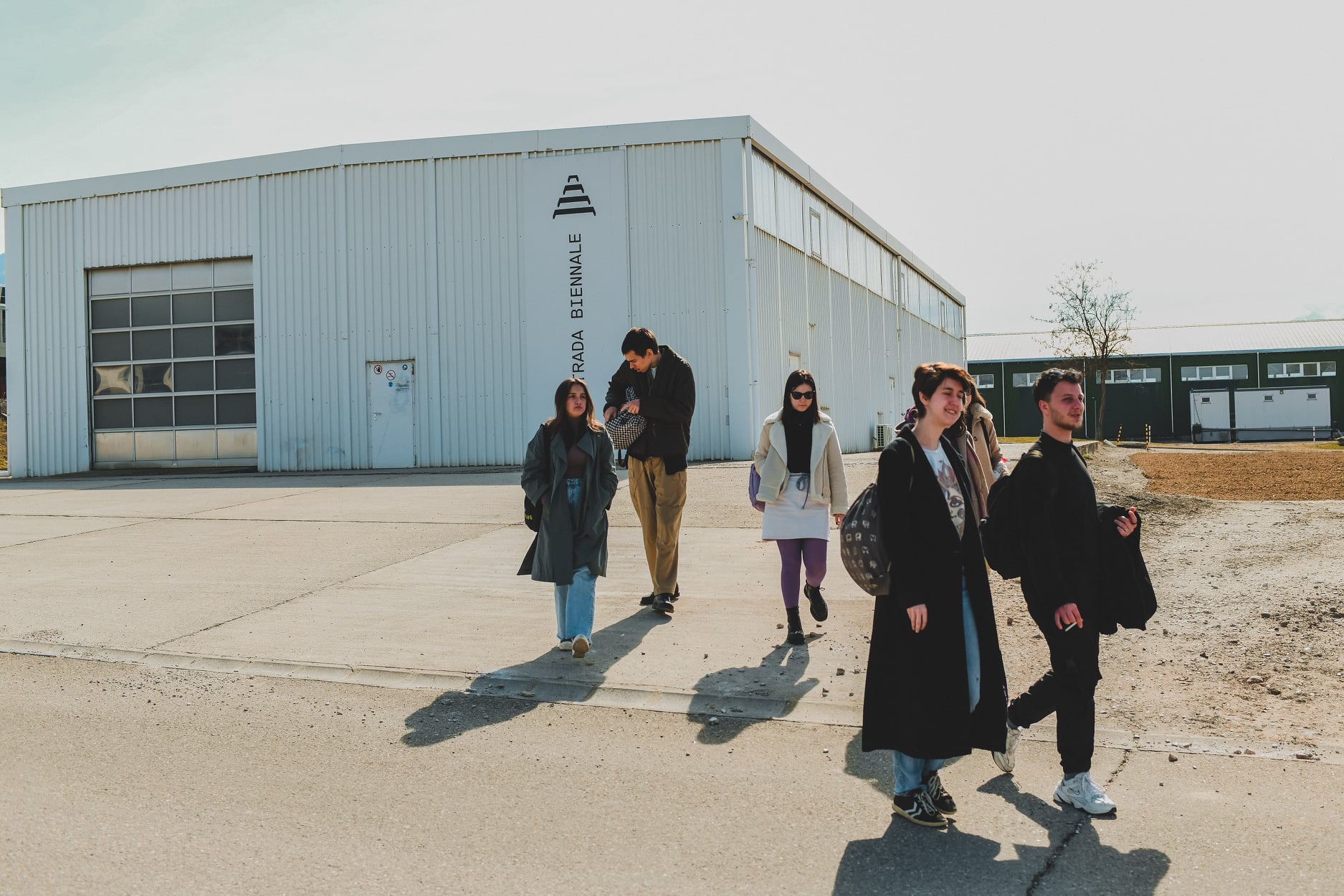 DAY 3
On our third trip, we departed for our Gjakova trip in the morning. By 10:00 we were welcomed by the BoneVET Gjakova staff, who introduced us to their institutions and their educational courses which have a strong focus on engineering and science, aiming to help young people find their calling. The participants were introduced to coding, they even had to code a small robot and then watch how it responds, all with the assistance of the staff of BoneVET. At the end of the visit, the participants had to make a bookmark with the origami method.
DAY 3
On our third trip, we departed for our Gjakova trip in the morning. By 10:00 we were welcomed by the BoneVET Gjakova staff, who introduced us to their institutions and their educational courses which have a strong focus on engineering and science, aiming to help young people find their calling. The participants were introduced to coding, they even had to code a small robot and then watch how it responds, all with the assistance of the staff of BoneVET. At the end of the visit, the participants had to make a bookmark with the origami method.
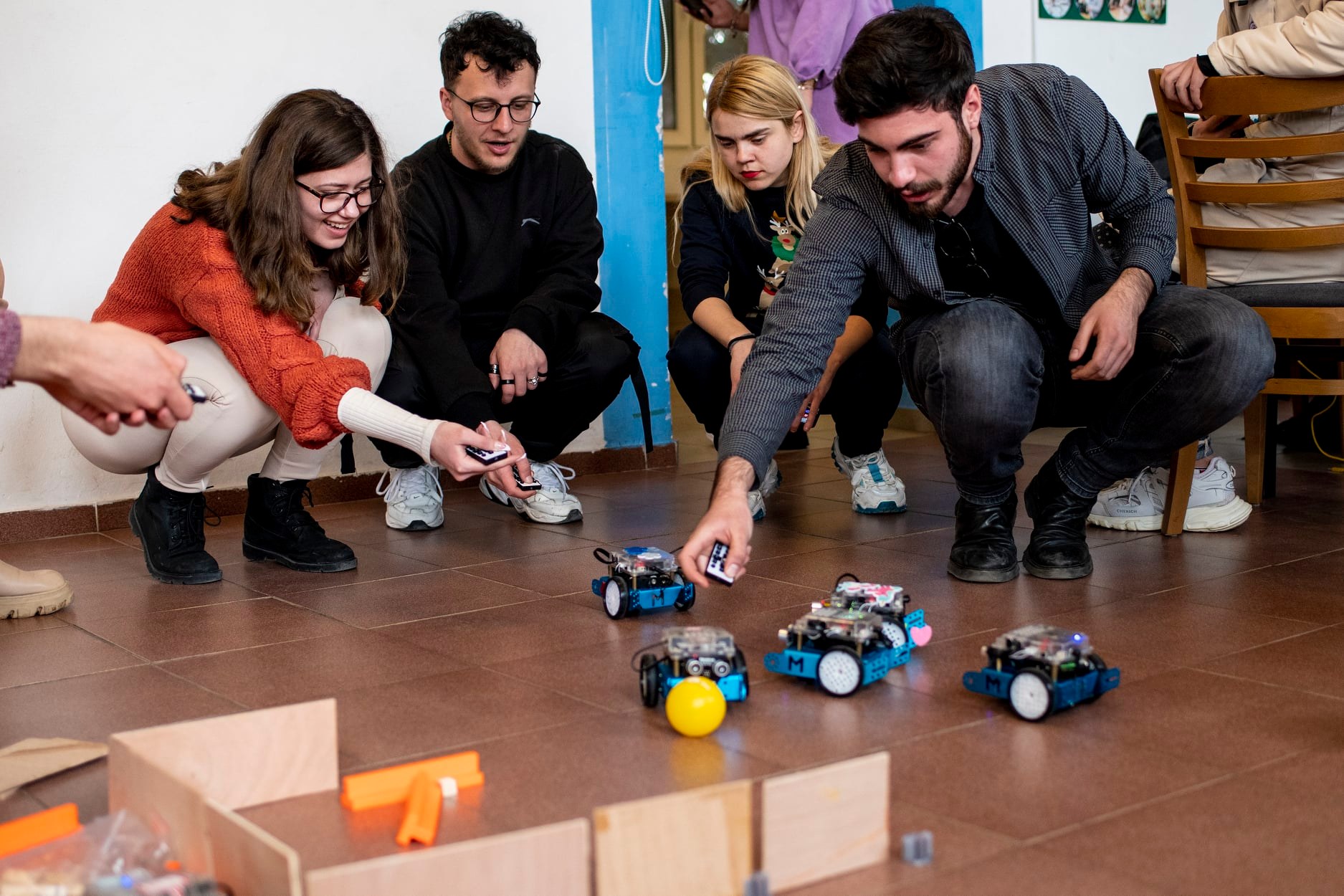 We headed out to Peja after the BoneVet visit, fitting a visit at the Patriarchy of Peja Serbian Orthodox monastery, before taking a lunch break as soon as we arrived at ERA Restaurant.
We headed out to Peja after the BoneVet visit, fitting a visit at the Patriarchy of Peja Serbian Orthodox monastery, before taking a lunch break as soon as we arrived at ERA Restaurant.
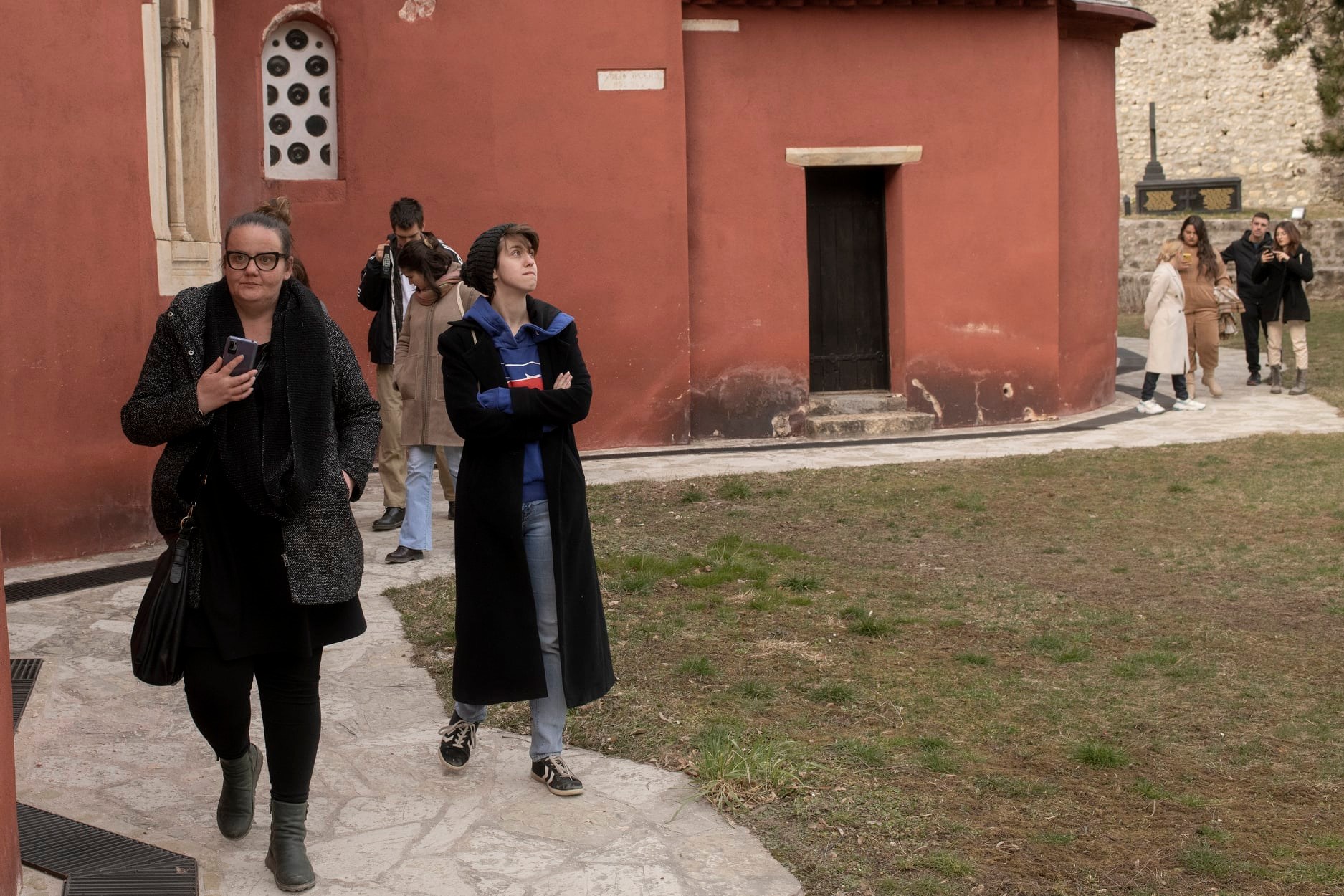 In Peja, we visited Anibar, the first animation film festival in Kosovo. The staff of Anibar gave us a presentation about how they operate and encouraged our participants to ask questions, at the cinema of Jusuf Gervalla.
In Peja, we visited Anibar, the first animation film festival in Kosovo. The staff of Anibar gave us a presentation about how they operate and encouraged our participants to ask questions, at the cinema of Jusuf Gervalla.
 Seeing that our participants had really gotten along with the Team of Anibar, we invited them to join us for dinner at the old stone tower called Kulla e Zenel But, after having accommodated our participants at their hostel.
DAY 4
On our fourth day, we departed from Peja to Mitrovica. Our trip to Mitrovica was entirely organized by Lulzim Hoti, 7 Arte founder, an NGO in Mitrovica focused on art and repurposing abandoned buildings in the city, as well as the organization of Green Fest, a multidisciplinary festival that aims to raise awareness of environmental issues.
In Mitrovica, we visited the famous bridge that connects the South and the North of Mitrovica. We were investigated by the Italian police at the bridge because our photographers were carrying their cameras, however upon explaining the nature of our activity we were allowed to proceed.
In North Mitrovica, we visited three points, the main square, the Aquaria Cafe and Art Gallery, and a Bosnian neighborhood.
The Aquarius Cafe and Gallery, owned by a close friend 7 Arte’s Lulzim, ___ Milijana, and her husband, is the home of nearly 2000 paintings. Miljana, a strong advocate of merging the gap between the North and South Mitrovica has organized several activities with the focus on merging this gap and lectured our participants on the role the media plays in emphasizing these differences.
Seeing that our participants had really gotten along with the Team of Anibar, we invited them to join us for dinner at the old stone tower called Kulla e Zenel But, after having accommodated our participants at their hostel.
DAY 4
On our fourth day, we departed from Peja to Mitrovica. Our trip to Mitrovica was entirely organized by Lulzim Hoti, 7 Arte founder, an NGO in Mitrovica focused on art and repurposing abandoned buildings in the city, as well as the organization of Green Fest, a multidisciplinary festival that aims to raise awareness of environmental issues.
In Mitrovica, we visited the famous bridge that connects the South and the North of Mitrovica. We were investigated by the Italian police at the bridge because our photographers were carrying their cameras, however upon explaining the nature of our activity we were allowed to proceed.
In North Mitrovica, we visited three points, the main square, the Aquaria Cafe and Art Gallery, and a Bosnian neighborhood.
The Aquarius Cafe and Gallery, owned by a close friend 7 Arte’s Lulzim, ___ Milijana, and her husband, is the home of nearly 2000 paintings. Miljana, a strong advocate of merging the gap between the North and South Mitrovica has organized several activities with the focus on merging this gap and lectured our participants on the role the media plays in emphasizing these differences.
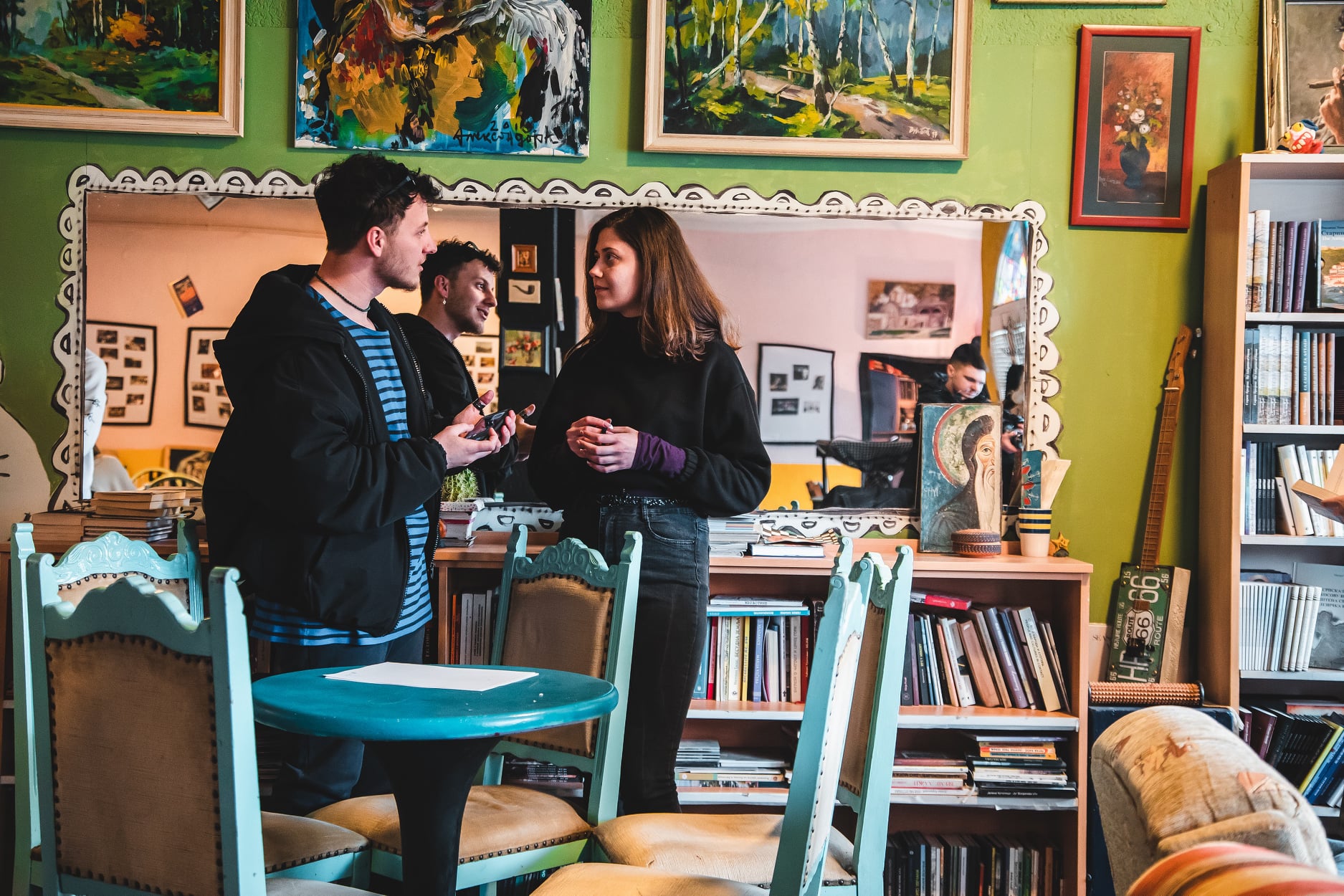 In the Bosnian neighborhood, we were surprised to discover that people could talk in Albanian freely and challenged our conviction that the Albanian language is strictly forbidden in North Macedonia.
After having concluded our visit to North Macedonia we visited the museum of the city of Mitrovica where Nora Prekazi presented us the artifacts and gave a short introduction about the museum and its belongings.
We also paid a quick visit to the 7 Arte offices and then headed out to Prishtina where we also ate dinner after we got accommodated at ODA Hostel.
In the Bosnian neighborhood, we were surprised to discover that people could talk in Albanian freely and challenged our conviction that the Albanian language is strictly forbidden in North Macedonia.
After having concluded our visit to North Macedonia we visited the museum of the city of Mitrovica where Nora Prekazi presented us the artifacts and gave a short introduction about the museum and its belongings.
We also paid a quick visit to the 7 Arte offices and then headed out to Prishtina where we also ate dinner after we got accommodated at ODA Hostel.
 DAY 5
Our day in Prishtina started off with a visit to Manifesta Biennial, we were welcomed by the director of the cultural biennale herself Nita Deda, who gave us all a short description of the Biennial, its importance, its journey, research in different cultural and educational fields, etc. At the end of the tour, the Manifesta staff provided different brochures, posters, and postcards to all the participants of the project.
DAY 5
Our day in Prishtina started off with a visit to Manifesta Biennial, we were welcomed by the director of the cultural biennale herself Nita Deda, who gave us all a short description of the Biennial, its importance, its journey, research in different cultural and educational fields, etc. At the end of the tour, the Manifesta staff provided different brochures, posters, and postcards to all the participants of the project.
 Our tour to Prishtina continued with Foncadioni 17. The co-founder of this Foundation Ajete Kerqeli gave a video presentation to all the attendants about their work and different exhibitions that they have organized during their four years of existence as a Foundation.
Our tour to Prishtina continued with Foncadioni 17. The co-founder of this Foundation Ajete Kerqeli gave a video presentation to all the attendants about their work and different exhibitions that they have organized during their four years of existence as a Foundation.
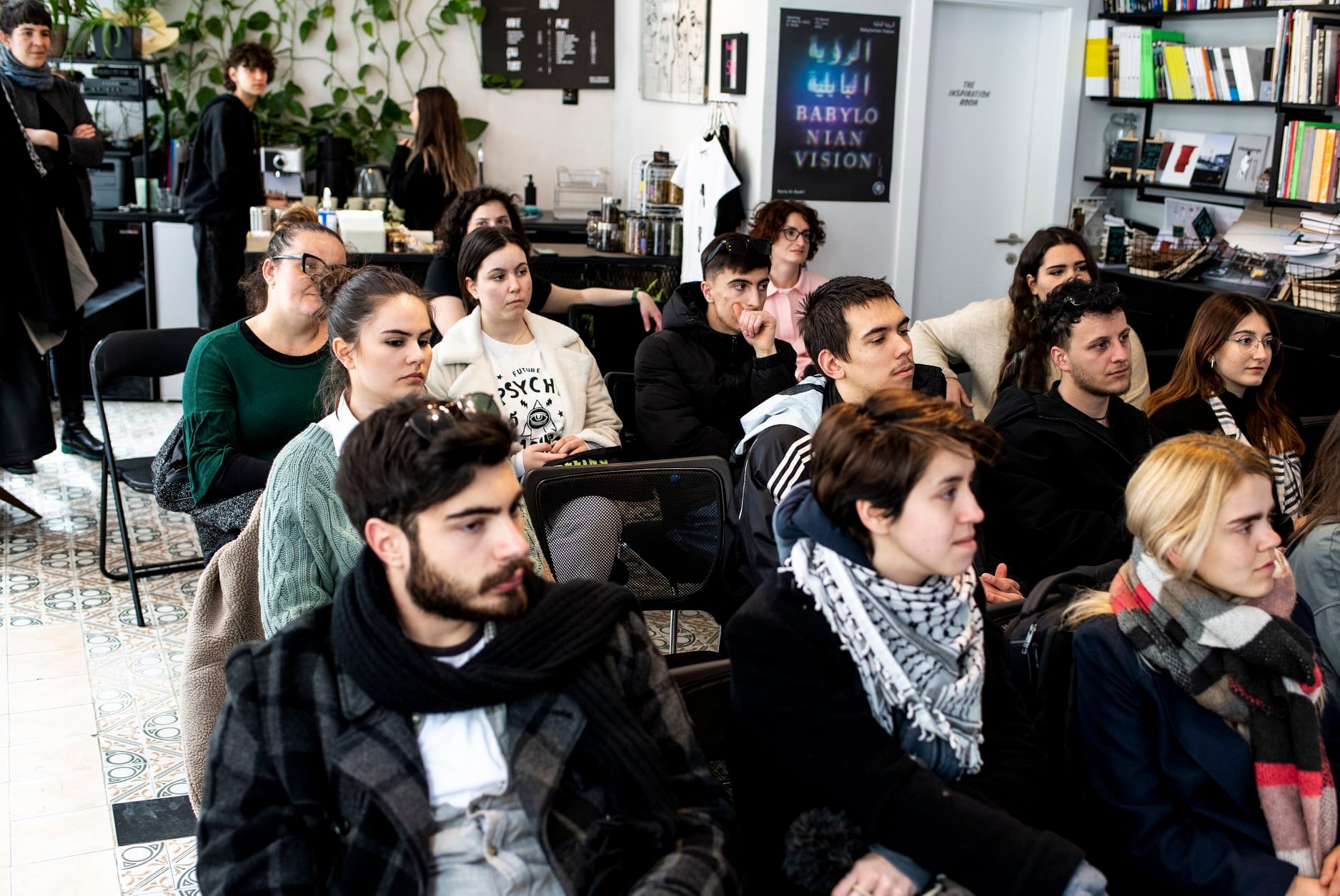 The third location for visit in Prishtina was Kosovo 2.0, an independent media organization. The presentation for Kosovo 2.0 was made by Ilirjan Banjska – Managing Editor of this media and Aulone Kadriu – Editor of this media. They both shared their experiences in finding and writing the news, gaining the trust of the storyteller, their consistency, filers through which the story and writing, etc.
The third location for visit in Prishtina was Kosovo 2.0, an independent media organization. The presentation for Kosovo 2.0 was made by Ilirjan Banjska – Managing Editor of this media and Aulone Kadriu – Editor of this media. They both shared their experiences in finding and writing the news, gaining the trust of the storyteller, their consistency, filers through which the story and writing, etc.
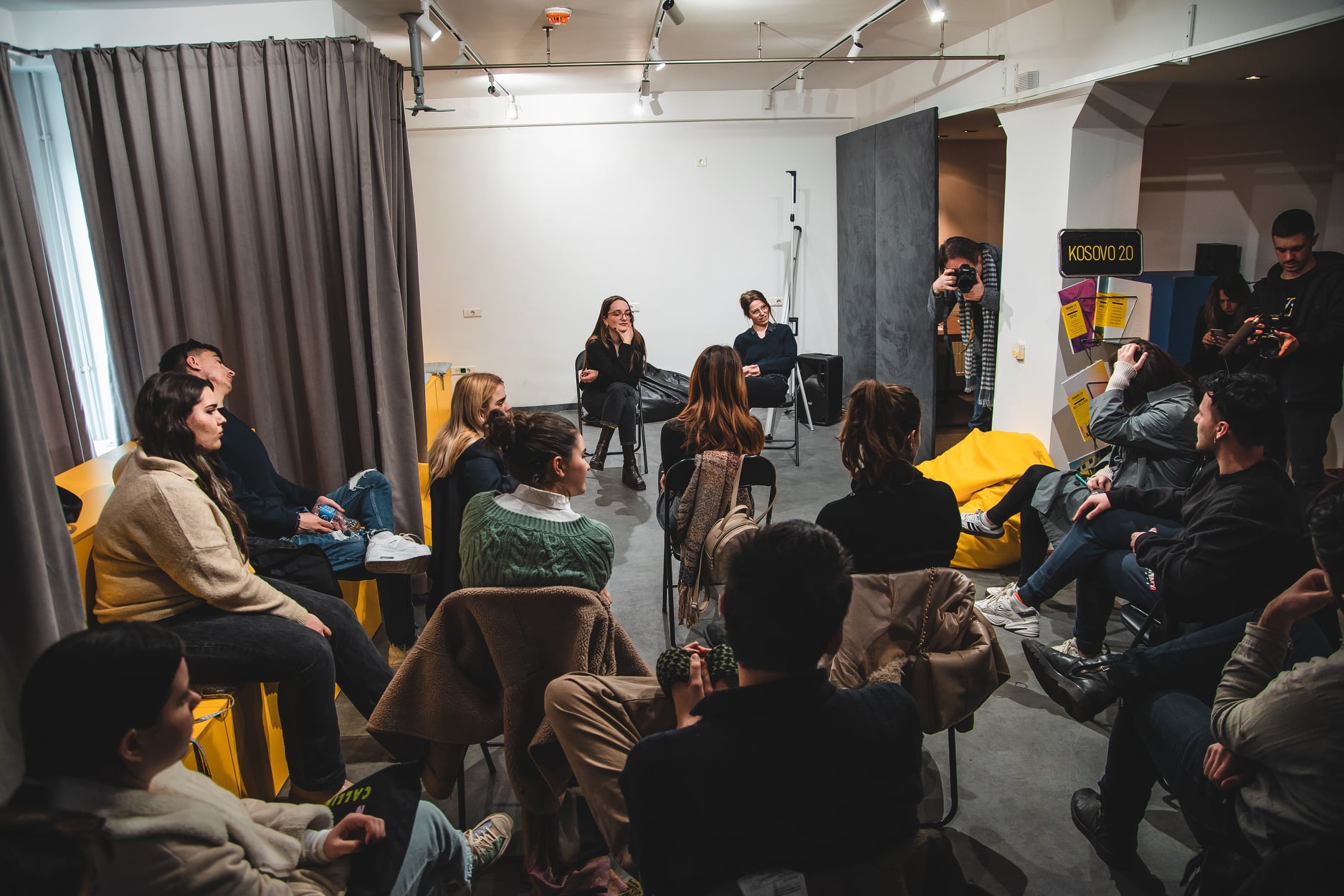 The fourth visit to the Humanitarian Law Center in Kosovo and Documentation Center in Hivzi Sylejmani Library in Prishtine, was a grim one as we explored the “Na ishte nje here, qe kurr te mos qoft” exhibition, dedicated to all the children that lost their lives during the war in Kosovo from 1998 to 1999. It was a really touching and challenging experience for all of us, and a monumental point for the project's agenda.
We then returned to Prizren and went to dinner, where we reflected upon our experiences so far.
The fourth visit to the Humanitarian Law Center in Kosovo and Documentation Center in Hivzi Sylejmani Library in Prishtine, was a grim one as we explored the “Na ishte nje here, qe kurr te mos qoft” exhibition, dedicated to all the children that lost their lives during the war in Kosovo from 1998 to 1999. It was a really touching and challenging experience for all of us, and a monumental point for the project's agenda.
We then returned to Prizren and went to dinner, where we reflected upon our experiences so far.
 DAY 6
On our 6th day of the camp, we returned to Autostrada Biennale Hangar, for interviews and shooting day.
DAY 7
On the final day, we held a recap session, reflecting on the experiences that happened throughout the camp, at DokuKino, before the participant departed from Prizren at 12:00.
To watch all the videos created from participants of Group 3, click here
This grant is funded by the European Union and implemented by DokuFest and Foundation Fund B92
DAY 6
On our 6th day of the camp, we returned to Autostrada Biennale Hangar, for interviews and shooting day.
DAY 7
On the final day, we held a recap session, reflecting on the experiences that happened throughout the camp, at DokuKino, before the participant departed from Prizren at 12:00.
To watch all the videos created from participants of Group 3, click here
This grant is funded by the European Union and implemented by DokuFest and Foundation Fund B92



